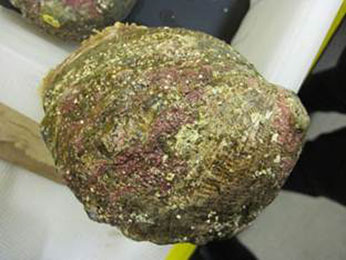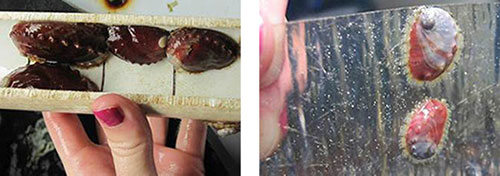 An adult white abalone used in the captive breeding program.
An adult white abalone used in the captive breeding program.
White abalone (Haliotis sorenseni) could once be found from Baja California to Point Conception and the Channel Islands. Populations significantly declined in the 1970s as the result of commercial fishing and in 2001 they became the first marine invertebrate to be federally listed as an endangered species. The prognosis for recovery in the wild is poor with an expectation that the species will likely go extinct without human intervention.
A white abalone recovery plan was developed by the National Marine Fisheries Service. In addition to preventing harvest, protecting habitat, and surveying wild populations, the key action is to propagate the species in captivity with the ultimate goal of outplanting captive-reared larvae, juveniles, and adults into their native range. Our lab is responsible for maintaining the health of captive white abalone populations and assisting with spawning efforts conducted by colleagues at our host facility, the Bodega Marine Laboratory (BML), as part of the White Abalone Recovery Program(opens in new tab).
Previous attempts at captive propagation were hindered by high mortality rates from withering syndrome. We recently developed an antibiotic bath treatment to eradicate the bacterial pathogen that causes the disease. Shell-boring organisms, which include sponges, polychaetes, and bivalves, may exert additional stress on abalone and facilitate opportunistic microbes that cause shell lesions. To exterminate these boring organisms, our lab utilizes a method that involves covering the dorsal surface of the shell with a wax compound.
Our continued efforts to maintain captive abalone at BML and partner institutions are focused on monitoring health, preventing occurrences of diseases and pests, and researching the cause of shell lesions, which hinder recovery efforts in progress.
 Juvenile white abalone, the result from successful spawns in 2012 and 2013, respectively.
Juvenile white abalone, the result from successful spawns in 2012 and 2013, respectively.
 The three photographs above show a captive wild-origin white abalone undergoing wax treatment to kill shell-boring organisms that eroded its shell.
The three photographs above show a captive wild-origin white abalone undergoing wax treatment to kill shell-boring organisms that eroded its shell.